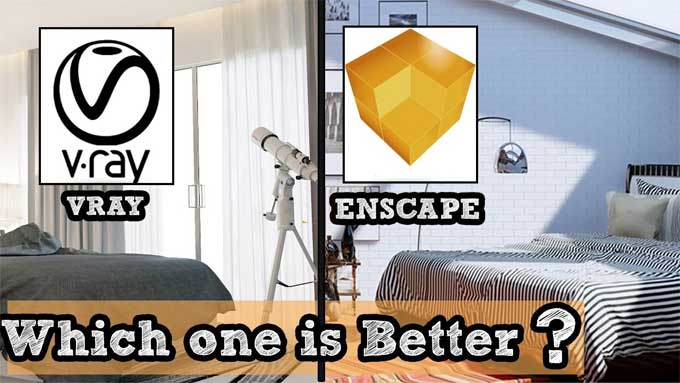Which is better: V-Ray or Enscape?

Designers are always on the lookout for realistic projections to create their designs; they believe that this is the key to gaining the client's approval since it provides a look at the final outcome before building sites are started.
There are a number of rendering engines available on the market today, but Vray and Enscape are two of the most well-known ones.
When it comes to rendering, the details are what will ultimately determine which one you select. In other words, your tasks are not only determined by your skill sets and texturing talents. In such a crowded field, you'd want your work to stand out and capture the attention of the intended audience.
V-Ray
This is a tool that creates realistic renderings of SketchUp models by collaborating with the V-Ray rendering engine. This technique can also be used in VFX and cinematography in order to spawn objects. In the design industry, it is one of the strongest products.
Enscape
Enscape gives photo-realistic results utilizing the latest technologies in order to achieve better results. Originally designed in 2013, the software has gained a great deal of success since 2015, and is now used in over 80 countries.
Also, Enscape collaborates with a variety of BIM and CAD software, and it is ranked in the top 100 architectural firms in the world.
Comparison
In terms of modeling
V-Ray: V-Ray is both a tool and an extension because it works seamlessly with SketchUp. It is well-shaped with the Sketch-up interface in mind, and Vray is just utilized for the return component. It has a basic border and is connected to the Sketch-up interface; it does not have a lot of features and settings.
VRay provides a huge selection of materials for the inside and exterior, both natural and artificial, and the user may configure it by altering the color of the material, the opacity, the thought, the refraction, and adding additional texture, among other possibilities.
Enscape: Enscape, on the other hand, has a fantastic engine called "Virtual Reality" that allows users to save time and money for the customer.
This option restores the ability to navigate inside the project and learn all of the design's elements and intricacies. This action allows the customer to see the finished product before it is built, allows adjustments to be made before finishing the pose, and helps to avoid work gaps.
In terms of setting
V-Ray: Users in V-Ray can decide whether the engine rendering CPU or GPU. It is also able to choose the pitch quality, which ranges from low to medium to high. As for the camera, the user may pick from three natures: conventional, and VR geometric cameras.
The consumer may also activate or deactivate the exposure, as well as define its value, which is related to the camera's light sensitivity.
You may also utilize V-ray to select the image's resolution or one of the aspect ratio options, as well as provide a backdrop for external rendering.
Enscape: Enscape has a lot of levels, ranging from buttons and mouse setup to rendering style preferences. This option allows users to customize the rendering style in Enscape by adjusting the outline and state.
The user may also pick polystyrol mode and set up the transmission, which regulates the quality of ignited transferred through geometry. When combining these two modes, it is best to employ the dump delineates option as well for better results.
In terms of adaptation
V-Ray: Understanding, the few options, and implements that are available don't take a lot of time, but to get a better understanding of the different configurations and to work in more detail. It is best to go through training or watch lessons.
Enscape: Using Enscape is much easier than working with, collaborating with, and configuring it. There are no special tools or options required, so there is no need for training. Students and apprentices in the design industry will enjoy this software.
In terms of animation
V-Ray: The final rendering and animation output from V-ray is quite realistic, especially for the interior design elements.
V-Ray gives a lot of weight to the materials, igniting, and settlers before they render, and a lot of additional render configurations, such as providing composition, forethought, and refraction.
Last-minute study results are heavily influenced by all of these circumstances. It is also feasible to alter the last-minute interpretation in the same window.
To learn more, watch the following video tutorial.
Video Source: Banharak tutorial
Enscape: Enscape can yield any type of project, interior or exterior, scenery, hotels, etc.
The software also comes with a substantial library full of components; it is also compatible with the components and the qualities of the pose application. Enscape offers the living and videos alternative and likewise panoramic pictures.



